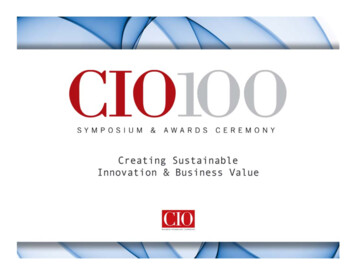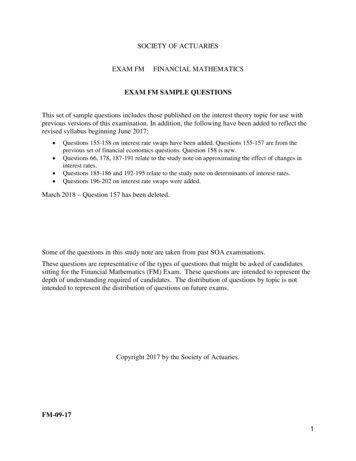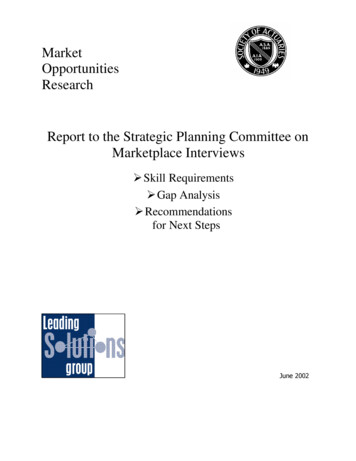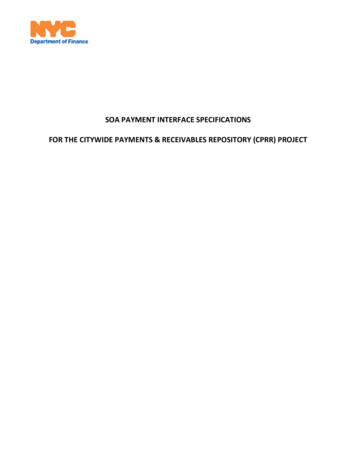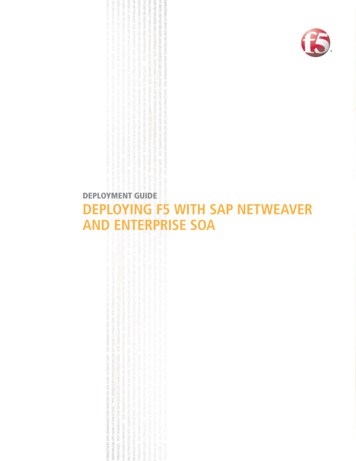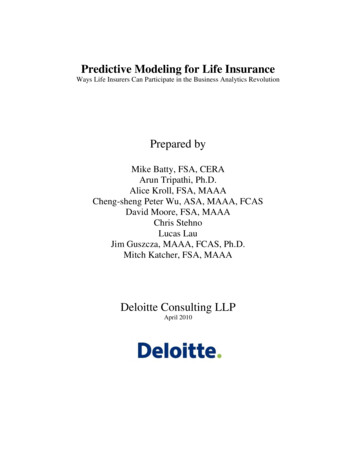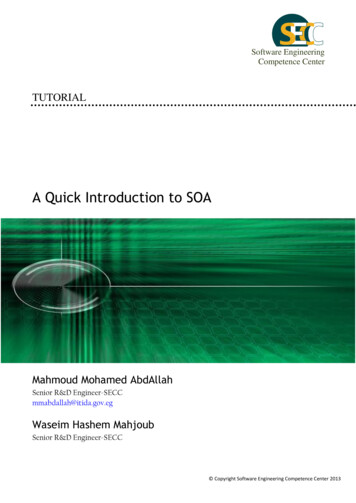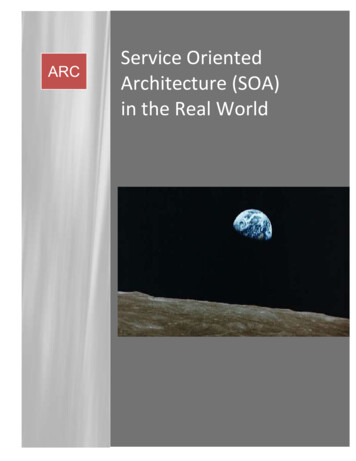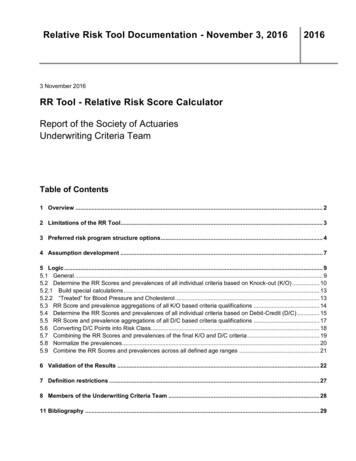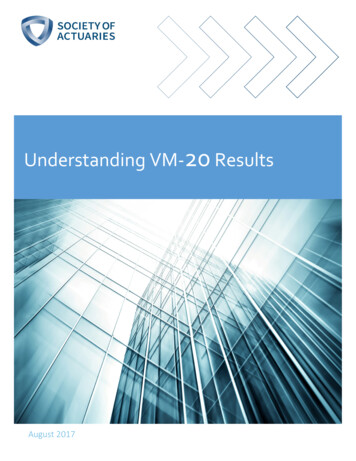
Transcription
Understanding VM-20 ResultsAugust 2017
Understanding VM-20 ResultsSPONSORFinancial Reporting SectionProduct Development SectionSmaller Insurance Company SectionCommittee on Life InsuranceResearchAUTHORSSeng-Siang Goh, FSA, MAAAWilliam Hines, FSA, MAAAMike Nam, FSA, MAAAKaren Rudolph, FSA, MAAAWilliam Sayre, FSA, MAAATung Tran, ASA, MAAADavid Wang, FSA, MAAAThe Sponsors and Authors would like to thank the following members of the Project Oversight Group:Leonard Mangini—ChairGilbert BooherGrace ChangThomas ChamberlainDonna MegregianKevin PiotrowskiCaveat and DisclaimerThis study is published by the Society of Actuaries (SOA) and contains information from a variety of sources. It may or may notreflect the experience of any individual company. The study is for informational purposes only and should not be construed asprofessional or financial advice. Neither the SOA, the authors nor Milliman recommend or endorse any particular use of theinformation provided in this study. Neither the SOA, the authors nor Milliman make any warranty, express or implied, orrepresentation whatsoever and assume no liability in connection with the use or misuse of this study.Copyright 2017 by the Society of Actuaries. All rights reserved.
CONTENTSBackground .5Disclaimer of Liability .5Report Content .6Executive Summary.7Introduction . 10Section 1: Sources of Change in Reserve . 12Economic Assumptions . 13Non-economic Assumptions . 16Demographics of the In-Force Policy Portfolio . 18Risk Mitigation Programs; Management Actions; Other . 19Section 2: Components of Change in Reserve in the Context of VM-20 . 21Economic Assumptions . 21Non-economic Assumptions . 24Demographics of the In-Force Portfolio . 27Risk Mitigation Programs; Management Actions; Other . 27Section 3: Overview of Reporting Regimes . 28MCEV . 29MCEV versus VM-20 Reserves . 29Attribution Elements of MCEV That May Be Relevant to VM-20 . 30CFO Forum MCEV Movement Analysis Template. 31AG 43 . 32AG 43 versus VM-20 Reserves . 32Attribution Elements of AG 43 Relevant to VM-20 . 32Sample AG 43 Movement Analysis Template . 35U.S. GAAP . 36U.S. GAAP versus VM-20 Reserves . 36Attribution Elements of U.S. GAAP Relevant to VM-20 . 36Sample U.S. GAAP Movement Analysis Template . 38IFRS . 39IFRS versus VM-20 Reserves . 39Attribution Elements of IFRS Relevant to VM-20 . 39Sample IFRS Movement Analysis Template . 40CALM . 41Copyright 2017 Society of Actuaries
CALM versus VM-20 Reserves . 41Attribution Elements of CALM That Are Relevant to VM-20 . 42Sample CALM Movement Analysis Template . 43Section 4: Company Interviews . 44Financial Reporting Regimes Used . 44What Analysis Tool Is Most Frequently Used to Understand Period-to-Period Changes? 44Is There Consistency in Attribution Analysis Methods between Regimes, if More than OneRegime Is Used? . 45Describe Management’s Use of and Attention to the Attribution Analysis Provided . 46How Would You Like to Improve Your Work in the Area of Attribution Analysis?. 46Are Graphical Presentations Used to Present the Attribution Analysis?. 47Have You Thought about the Analysis Method Best Suited to Explaining Period-to-PeriodReserve Results for VM-20? . 47What Aspects of VM-20 Valuations Will Be Most Challenging with Respect to Volatility ofReported Results? . 48What Tools Do You Wish You Had Available for Analyzing Period-to-Period Changes forVM-20 Reserves? . 49Discuss What You See as Educational Needs to Better Understand VM-20 Attribution.What Form Should This Take? . 49What about VM-20 Education for Senior Management? Is There a Need for a VM-20Primer for This Level? . 49Describe How You See the Valuation Actuarial Staff Communicating Statutory Results toBoard and Senior Management Five Years from Now. 50Section 5: Suggested Reserve Attribution for VM-20 and How-To Guide . 51Suggested Attribution Analysis . 51How-To Guide . 52Demographic Changes . 52Non-economic Changes . 54Economic Changes . 55Risk Mitigation . 57Section 6: Case Studies . 58VM-20 Product Group Definitions . 58Time 0 to Time 1 Changes Impacting the Attribution—Term Case Study . 59Attribution Grid—Term Case Study . 63Time 0 to Time 1 Changes Impacting the Attribution—ULSG Case Study . 66Attribution Grid– ULSG Case Study . 71Copyright 2017 Society of Actuaries
Understanding VM-20 ResultsBackgroundThe new principle-based framework for U.S. statutory reserves as defined in Chapter 20 of the NationalAssociation of Insurance Commissioners’ Valuation Manual (VM-20) may be used for life products issuedstarting in 2017. While research and educational materials have been produced to help actuaries andothers better understand the implications and implementation of the new requirements from avaluation perspective, little has been developed emphasizing the options for evaluating period-to-periodchanges in VM-20 reserves and communicating those changes to interested stakeholders.The Society of Actuaries’ Financial Reporting Section, Product Development Section, Smaller InsuranceCompany Section and the Committee on Life Insurance Research engaged Milliman to examine optionsfor analyzing these periodic changes in VM-20 reserve amounts. The research surveys the sources ofreserve movement and volatility, surveys other reporting regimes for potential attribution approaches,conducts interviews with financial reporting actuaries regarding their use of attribution methods andprovides a demonstration of a proposed attribution approach for a case study for VM-20 valuations.Disclaimer of LiabilityThis report is to be reviewed and understood as a complete document. Any distribution of this reportmust be in its entirety. Nothing contained in this report is to be used in any filings with any public body,including, but not limited to, state regulators, the Internal Revenue Service and the U.S. Securities andExchange Commission.This report has been published by the Society of Actuaries (SOA) and contains information based oninput from companies engaged in the U.S. life insurance industry. It may or may not reflect theexperience of any individual company. The SOA, the authors and Milliman do not recommend,encourage or endorse any particular use of the information provided in this report. Any results orobservations made may not be indicative of the impact on any particular product or company and maynot be representative of the life insurance industry as a whole. It is for informational purposes only. It isnot intended to guide or determine any specific individual situation, and persons should consultqualified professionals before taking specific actions. The opinions expressed and conclusions reachedby the authors are their own and do not represent an official position or opinion of the SOA or itsmembers or Milliman. Neither the SOA, the authors nor Milliman makes any warranties, guarantees orrepresentations whatsoever regarding the accuracy or completeness of the content of this report. Thestudy should not be construed as professional or financial advice. Neither the SOA, the authors norMilliman shall have any responsibility or liability to any person or entity with respect to damages allegedto have been caused directly or indirectly by the content of this report.With the January 1, 2017, effective date of VM-20, we expect that actuarial practice in calculating VM20 reserves and reflecting reserve changes through attribution analysis will evolve over time ascompanies, actuaries and regulators gain experience in calculating such reserves. The evolving actuarialpractice may differ from what is assumed in the case studies. The methodology and assumptions used in5
developing VM-20 reserves for the case studies are illustrative and should not be viewed asrecommendations of the SOA, the authors or Milliman with respect to the application of VM-20.Further, future changes are expected in VM-20, including changes to certain prescribed assumptionssuch as defaults and spread assumptions as well as potential re-parameterization of the Net PremiumReserves. In addition, there is a lack of guidance from the U.S. Treasury concerning the appropriate taxreserves after VM-20 becomes effective. The reserves and attribution analysis examples included in thisreport are intended for illustration purposes only.Report ContentThe report is organized into three broad areas.Components of Period-to-Period Change: Section 1 provides an inventory of the components of periodto-period change in reserve and how these elements introduce volatility in the movement of reservefrom one period to the next. Section 2 discusses these components in the context of VM-20 principlebased reserve calculations.Comparative Approaches to Attribution Analysis: Section 3 surveys the landscape of financial reportingregimes at a high level and discusses how each of five reporting regimes approaches the reserveattribution analysis. Section 4 provides a practical look into the use of attribution analyses in insurancecompanies through interviews with financial reporting actuaries
5 . Understanding VM-20 Results . Background . The new principle-based framework for U.S. statutory reserves as defined in Chapter 20 of the National
